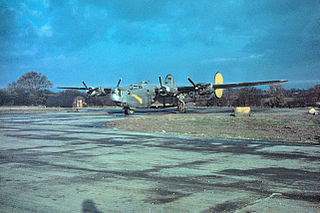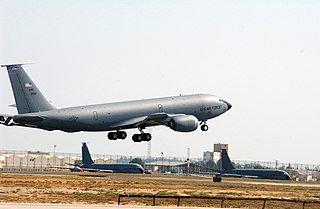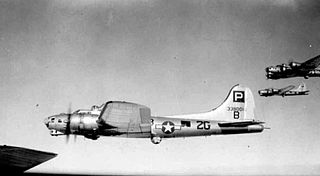
Royal Air Force Glatton or more simply RAF Glatton is a former Royal Air Force station located 10 miles (16 km) north of Huntingdon, Cambridgeshire, England.

The 487th Air Expeditionary Wing is a provisional United States Air Force unit assigned to the United States Air Forces in Europe. As a provisional unit, it may be activated or inactivated at any time. The unit's last known assignment was in 2003 at Cairo West Air Base, Egypt, during Operation Iraqi Freedom.

The 447th Air Expeditionary Group is a provisional United States Air Force unit assigned to the Air Combat Command (ACC) and United States Air Forces Europe (USAFE). The unit is currently stationed at Incirlik Air Base, Turkey in support of Operation Inherent Resolve.

The 458th Air Expeditionary Group is a provisional United States Air Force unit assigned to United States Air Forces in Europe to activate or inactivate as needed. The most recent known activation of the unit was at Ramstein Air Base, Germany in 2011.

The 453rd Bombardment Group is an inactive United States Air Force unit that was first organized in June 1943, during World War II, as a Consolidated B-24 Liberator heavy bomber group. After training in the United States, it deployed to England in December 1943, and, starting in February 1944, participated in the strategic bombing campaign against Germany with Eighth Air Force. Its 733d Bombardment Squadron completed 82 consecutive missions without a loss, a record for Eighth Air Force bomber units. James Stewart, of film fame, was group operations officer from 31 March to 1 July 1944. The group was programmed for redeployment to the Pacific and returned to the United States in May 1945 for training, however the Japanese surrender cancelled these plans and the group was inactivated in September 1945.

The 493d Bombardment Group is a former United States Army Air Forces unit that was assigned to the 92d Bombardment Wing during World War II. It the last bombardment group to be assigned to Eighth Air Force. It flew combat missions in the strategic bombing campaign against Germany until shortly before V-E Day, then returned to the United States for inactivation. In 2002, the group was converted to provisional status as the 493d Air Expeditionary Group and assigned to Air Mobility Command to activate or inactivate as needed.

The 55th Air Refueling Squadron is an inactive United States Air Force unit. It formerly operated both the combat crew training school and central flight instructor course for Boeing KC-135 Stratotanker at Altus Air Force Base, Oklahoma.

The 847th Bombardment Squadron is a former United States Army Air Forces unit that was originally activated as the 421st Bombardment Squadron. Its last assignment was with the 489th Bombardment Group at Great Bend Army Air Field, Kansas where it was inactivated on 28 March 1945. As the 20th Antisubmarine Squadron, the squadron performed antisubmarine patrols in 1942 and 1943. After reforming as a heavy bomber squadron, it engaged in the strategic bombing campaign against Germany in the European Theater of Operations until returning to the United States in late 1944. The squadron was inactivated while its parent group was training as a very heavy bombardment unit.

The 303rd Air Expeditionary Group is a provisional United States Air Force unit. In 2011, it was assigned to United States Air Forces Europe to activate or inactivate as needed.

The 748th Bombardment Squadron is a former United States Army Air Forces unit. The squadron was first activated in July 1943. After training in the United States, it deployed to the European Theater of Operations, where it participated in the strategic bombing campaign against Germany. Following V-E Day, the squadron returned to the United States and was inactivated in August 1945.

The 749th Bombardment Squadron is a former United States Army Air Forces unit. The squadron was first activated in July 1943. After training in the United States, it deployed to the European Theater of Operations, where it participated in the strategic bombing campaign against Germany. Following V-E Day, the squadron returned to the United States and was inactivated in August 1945.

The 750th Bombardment Squadron, 457th Bombardment Group, is a former United States Army Air Forces unit. The squadron was first activated in July 1943. After training in the United States, it deployed to the European Theater of Operations, where it participated in the strategic bombing campaign against Germany. Following V-E Day, the squadron returned to the United States and was inactivated in August 1945.

The 751st Bombardment Squadron is a former United States Army Air Forces unit. The squadron was first activated in July 1943. After training in the United States, it deployed to the European Theater of Operations, where it participated in the strategic bombing campaign against Germany. Following V-E Day, the squadron returned to the United States and was inactivated in August 1945.

The 322d Expeditionary Reconnaissance Squadron is a provisional unit of the United States Air Force, assigned to Air Combat Command to activate or inactivate as needed.

The 359th Bombardment Squadron was a United States Air Force unit. It was last assigned to the 303d Bombardment Wing, stationed at Davis–Monthan Air Force Base, Arizona. It was inactivated on 15 June 1964.

The 360th Bombardment Squadron is an inactive United States Air Force unit. It last was assigned to the 303d Bombardment Wing, stationed at Davis-Monthan Air Force Base, Arizona. It was inactivated on 15 June 1964.

The 366th Bombardment Squadron is an inactive United States Air Force unit. It was first activated in March 1942. After training with Boeing B-17 Flying Fortress bombers in the United States, the squadron deployed to the European Theater of Operations, where it participated in the strategic bombing campaign against Germany. The squadron was twice awarded the Distinguished Unit Citation for its combat actions. Following V-E Day, it moved to the continent of Europe and engaged in photographic mapping until inactivating in December 1946.

The 900th Expeditionary Air Refueling Squadron is a provisional United States Air Force unit. It was last known to be assigned to the 398th Air Expeditionary Group at Incirlik Air Base, Turkey.

The 902d Expeditionary Air Refueling Squadron is an inactive United States Air Force unit. It was last assigned to the 70th Bombardment Wing at Clinton-Sherman Air Force Base, Oklahoma, where it was inactivated on 31 December 1969.

The 836th Bombardment Squadron was a United States Army Air Forces unit. It was activated in September 1943. After training in the United States, it deployed to the European Theater of Operations, where it engaged in combat in the strategic bombing campaign against Germany with Consolidated B-24 Liberators. In the summer of 1944, it was withdrawn from combat to convert to the Boeing B-17 Flying Fortress, then continued in combat with the 487th Bombardment Group until the spring of 1945. Following V-E Day, the squadron returned to Drew Field, Florida, where it was inactivated on 7 November 1945.


























